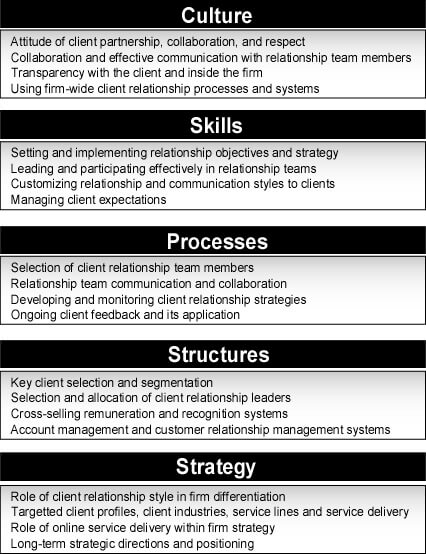The 5 elements of enhancing client relationship capabilities
Below is an excerpt from my book Developing Knowledge-Based Client Relationships 2nd Edition from Chapter 6 on Enhancing Client Relationship Capabilities: Implementing Key Client Programs.
See links to details on my work as a strategy advisor on client relationship leadership and my keynotes and workshops on building exceptional client relationships.
Enhancing Client Relationship Capabilities
Every firm has a certain set of capabilities in developing high-value client relationships. All successful firms will have at least reasonable capabilities in this domain, even if this has not been an overt focus in their management activities. The issue, whatever the current state of those capabilities, is how to continually enhance them. As you saw in Chapter 1, doing quality work is not enough. At every level from the top end of the market down, differentiation will increasingly stem from how well firms manage their client relationships. What was good enough a few years ago is not good enough today, and what is good today will simply not be adequate a few years from now.
There are five key domains which firms must address in order to enhance their client relationship capabilities on an ongoing basis, as illustrated below with representative activities for each domain. These are:
- Strategies
- Structures
- Processes
- Skills
- Culture

The five domains of enhancing client relationship capabilities
Professionals must understand that these five domains are inseparable—any initiatives must take into account each domain and how they interact. For example, for many firms the first step will be to introduce foundational structures for selecting and dealing with key clients. However for this to be effective, the design must stem from a clear understanding of the firm’s strategic directions, and it requires front-line professionals to have relevant skills in building broad client relationships. Certainly it would be challenging at best to obtain significant business results from these initiatives without a firm culture and behaviors that support the initiatives. As such firms must identify where they should focus their initial efforts in enhancing their overall client relationship capabilities, while always keeping in mind the broader context.
Here I will introduce the five key elements of enhancing client relationship capabilities. Each of these will be discussed in more detail over the next five chapters, with a consolidation of these themes into creating an action plan in Chapter 12.
Strategies
Many professional service firms fail to specify adequately how their business development initiatives relate to their strategic directions. Simply in order to be able to allocate relationship development efforts appropriately across existing and prospective clients, firms must have a clearly articulated vision of which industries, service lines, and types of service delivery they wish to develop. This requires examining how their business environment is shifting. One of the most useful approaches is to apply scenario planning to “the future of the client,” examining how in 5-10 years from now your clients and client industries may have evolved, especially in how they want and expect service delivery. This will inform current strategies and emphasis of business development activities. Whatever approach is used, it is critical to build a vision of how your clients and the marketplace are changing, and how you want your firm to be positioned in this future world.
Structures
Many firms have tended to focus on the relatively easy issues of underlying relationship structures, including selecting and segmenting key clients, and establishing account management planning and customer relationship management (CRM) software. Other key issues include implementing effective remuneration and recognition systems for cross-selling, and clear approaches to allocating client relationship leaders to key clients. Some of these can be overlaid on existing firm structure, but in other cases they require reappraisal of the formal structures. A common example is how many firms have substantially reorganized around industry lines in order to more effectively bring together disparate practice areas in creating client value.
Processes
Clearly defined processes should to be in place to support professionals in relationship development activities. These include processes for client relationship team formation, developing and monitoring client relationship strategies, and gathering useful client feedback. One of the most important issues is having clear processes in place for effective relationship team communication and collaboration, discussed in more detail in Chapter 9. Some of the processes can be formalized as standard practice, however many of the processes are essentially tools that are made available for relationship leaders to apply in running smooth and effective client relationship teams.
Skills
A core challenge for professional service firms is that their senior executives have all come from a deep functional specialization, and have rarely had specific skill development in client relationship management. The issue is taking technical professionals, and making them into true leaders that can inspire aligned action across the firm to address client challenges. High-level communication skills are required to manage client expectations effectively in complex relationships, and to customize service delivery and client communication according the client’s relationship style. Leading client relationship teams in particular requires key skills in setting and implementing relationship objectives and strategies, and fostering collaboration across diverse teams. Leadership development is discussed in Chapter 12.
Culture
Even if all of the other four key elements are in place, success is unlikely unless the firm has a culture that supports the development of deep client relationships. Professionals need to be driven not only to enhance client service and client knowledge, but also to collaborate with colleagues across different service lines and locations. Every firm must focus on continually enhancing their culture in supporting client relationship capabilities, through consistent, aligned communication, relevant remuneration structures, and effective leadership.



